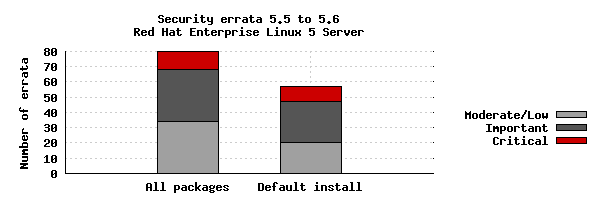17 Jan 2011: Enterprise Linux 5.5 to 5.6 risk report
Red Hat Enterprise Linux 5.6 was released last week (January 2011), nearly ten months since the release of 5.5 in March 2010. So let's use this opportunity to take a quick look back over the vulnerabilities and security updates made in that time, specifically for Red Hat Enterprise Linux 5 Server.Errata count
The chart below illustrates the total number of security updates issued for Red Hat Enterprise Linux 5 Server if you had installed 5.5, up to and including the 5.6 release, broken down by severity. It's split into two columns, one for the packages you'd get if you did a default install, and the other if you installed every single package (which is unlikely as it would involve a bit of manual effort to select every one). For a given installation, the number of package updates and vulnerabilities that affected you will depend on exactly what you have installed or removed.

So, for a default install, from release of 5.5 up to and including 5.6, we shipped 57 advisories to address 206 vulnerabilities. 10 advisories were rated critical, 27 were important, and the remaining 20 were moderate and low.
Or, for all packages, from release of 5.5 to and including 5.6, we shipped 80 advisories to address 300 vulnerabilities. 12 advisories were rated critical, 34 were important, and the remaining 34 were moderate and low.
Critical vulnerabilities
The 12 critical advisories addressed 49 critical vulnerabilities across just 3 different packages:
- An update to the Exim Internet Mailer, (December 2010), where an unauthenticated remote attacker could run arbitrary code as root on a server. Exim is not a default package or enabled by default. There is a public exploit for this issue which worked on Red Hat Enterprise Linux 5.
- Two updates over three advisories to Samba, (June 2010 for Samba 3.0 and Samba 3.3, September 2010 for Samba 3.0 and Samba 3.3), where a malicious client could send a specially-crafted SMB packet to the Samba server, potentially resulting in arbitrary code execution with the privileges of the Samba server. I'm not aware of any working public exploits for these issues.
- Eight updates to Firefox (March 2010, June 2010, 20 July 2010, 23 July 2010, September 2010, 19 October 2010, 27 October 2010, December 2010) where a malicious web site could potentially run arbitrary code as the user running Firefox.
Updates to correct 48 out of the 49 critical vulnerabilities were available via Red Hat Network either the same day or the next calendar day after the issues were public. The update to fix Exim took 3 calendar days from the date of the report to the Exim developers.
Overall, for Red Hat Enterprise Linux 5 since release until 5.6, 97% of critical vulnerabilities have had an update available to address them available from the Red Hat Network either the same day or the next calendar day after the issue was public.
Other significant vulnerabilities
Although not in the definition of critical severity, also of interest during this period were several kernel flaws that where an local user could gain root privileges. The following had publicly available exploits:- A fix for CVE-2010-2240 was provided by RHSA-2010-0661 (August 2010). The public exploit did not work against Red Hat Enterprise Linux 5, but it may be possible to create one that does.
- A fix for CVE-2010-3081 was provided by RHSA-2010-0704 (September 2010). The public exploit worked against Red Hat Enterprise Linux 5
- A fix for CVE-2010-3904 was provided by RHSA-2010-0792 (October 2010). The public exploit did not work against Red Hat Enterprise Linux 5 but it is possible to create one that does.
Previous updates
To compare these statistics with previous update releases we need to take into account that the time between each update is different. So looking at a default installation and calculating the number of advisories per month gives the following chart:

This data is interesting to get a feel for the risk of running Enterprise Linux 5 Server, but isn't really useful for comparisons with other major versions, distributions, or operating systems -- for example, a default install of Red Hat Enterprise Linux 4AS did not include Firefox, but 5 Server does. You can use our public security measurement data and tools, and run your own custom metrics for any given Red Hat product, package set, timescales, and severity range of interest.
See also: 5.4 to 5.5, 5.3 to 5.4, 5.2 to 5.3, 5.1 to 5.2, and 5.0 to 5.1 risk reports.
Created: 17 Jan 2011
Tagged as: cve, fedora, metrics, red hat, security
